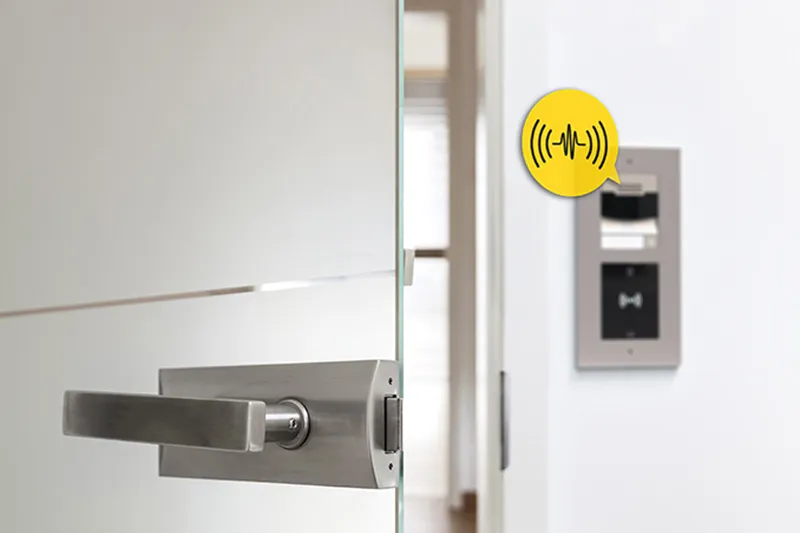Create Unique IP Intercom Scenarios With 2N Automation
Regular IP intercom settings not enough? Discover the almost endless potential of our devices in Automation and say ‘Yes!’ to any scenario your customer asks for.
What is Automation and what can it do to 2N IP Intercoms and access control readers?
You know the usual intercom set-up – the visitor calls, someone answers, and the door opens. Simple! However, sometimes, the regular settings just simply aren’t enough for your customers. This is where our Automation interface section in the 2N OS comes in. It lets you build on the existing features of 2N IP intercoms and access control readers to create advanced features individually tailored to your project. You can modify settings and create advanced scenarios for your customers – and it’s a vital part of any complete solution. All of that in a straightforward user interface and with no need to know how to programme.
Say, for example, your customer wants the building manager to be notified immediately when someone unauthorised forces a door open – Automation can make that happen, and more!
How do you set Automation up?
For convenience: choose from our pre-set scenarios
The flexible nature of Automation and the user-friendly interface makes it easy for you to create close to any scenario you need, however, we’ve also compiled a set of .AM files for commonly used scenarios:
- Intercom as part of a smart home
- Contactless intercom ringing
- Warning signal for doors open too long
- Picture to email plus motion detection
- One-off codes for visitors
- Intercoms for emergency communication
Just customise them slightly if needed, load them into the IP intercom via the 2N OS, and bill the customer! Find more info about Automation here.
 Stay up-to-date with the latest news. Subscribe to our newsletter.
Stay up-to-date with the latest news. Subscribe to our newsletter.
For advanced customisation: build your own scenarios
When making your own, there are three elements to Automation: predefined events, actions, and conditions. Drag them onto the desktop and link them to each other. In doing so, you’ll create a complex scenario that meets your customers’ needs with just a few clicks.
- Event – triggers the related action. For example, the press of a button, user authorisation, swiping of a card or PIN entry, detection of movement in front of the IP intercom camera, the door being kicked in, and so on.
- Action – something that happens and is triggered when a previously defined event occurs. May be subject to meeting a certain condition (see the next point). For example, user sounds, the activation of a switch, sending an HTTP command, a door opening, starting a call, sending an e-mail, and so on.
- Condition – you can set an action to be triggered only once a condition is met and are useful if you require more control over actions when they’re executed. If you don’t specify a condition, the action is performed whenever the event occurs. Conditions can be as follows: true, false, call status, security status, and so on.
So, in the previously mentioned case of a door being forced open – you’d set up a scenario as follows:
- The event is an unauthorised door open
- The actions can then be: a user sound (to warn trespassers), the building manager being sent an email, an HTTP request sent to the security office to trigger an alarm, and an ONVIF virtual input to be sent to the IP Intercom and/or other IP cameras to make them record what’s happening.
- The conditions can be: if the incident occurs during working hours - send info to the building manager, and if it's outside working hours - send the info to a security agency
A detailed description of Automation settings can be found in the Automation Manual for 2N IP intercoms and access control systems.
Automation loves integration!
Of course, Automation goes hand in hand with third-party integration – and that’s good because all 2N IP Intercoms and access control readers are built with integration in mind. We have over 300 technology partners, and build all our devices on open protocols, which means you can use them to work seamlessly into entire solutions. Automation furthers that and gives your customers solutions that work for their needs.
I’ve got a 2N IP Intercom: what do I need to get started?
In order to gain access to the unlimited world of automation, all you need to do is purchase a Gold Licence (9137909) If you have a new IP intercom and want to try out all the things Automation offers, activate a trial licence for 800 hours. You don’t need a licence for access control readers; those are already loaded into the devices.
Gold License unlocks a whole world of potential outside of automation: including other advanced features for video, integration, and lift control. Find out more!
Did you automate something great? Tell us!
Automation is also a vital tool we use to test potential functions of the 2N OS – and often, it’s you - our customers - that come up with the best ideas! Make sure you tell us what you think would make a great addition to our operating system: we’ve listened to you on many occasions.
Want to unlock the full potential of 2N solutions?
Make your 2N IP intercoms and access control readers capable of seriously clever stuff and please your customers whilst you’re at it.